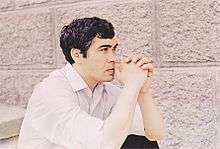Nury Halmammedov
| Nury Halmammedov | |
|---|---|
 | |
| Background information | |
| Born |
February 24, 1940 Baherden |
| Died | August 4, 1983 |
| Occupation(s) | Composer |
| Instruments | Pianoforte |
Nury Halmammedov (Turkmen: Nury Halmämmedow, also Nury Halmämmet, Russian: Нуры Халмамедов) (1940–1983)[1][2] was a prominent Turkmen composer described as one of Turkmenistan's "greatest sons".[3] His legacy has been commemorated with anniversary events within Turkmenistan.[4]
Early childhood and education
Nury Halmammedov was born on 24 February 1940 in Baherden, Turkmenistan to Halmämed and Hangül-Eje Baýlyew.[2][5] He had very difficult childhood. According to Jemile Gurbanowa's biography of Halmamedov, his mother died in 1944 when Halmammedov was four years old, and his father moved to Iran with two of the family's four sons, Begmamed and Ashirberdi, abandoning Nury, his 17-year-old brother, Bayly, and sister, Artyk. Bayly committed Nury to the Karakalinsk orphanage, but Nury was later transferred to the Baherden boarding school. At some point little Nury ran away from the boarding school, stowed away on a freight train, and ended up in Ashgabat. When discovered by authorities, since he had no papers and could not identify his parents, he was sent to the Baýramaly orphanage. Here he encountered a piano teacher, Olga Krivchenko, and began studying piano.[2]
From there he was transferred after three and a half years to Turkmen State Music School, where he studied under Elena Kulesh. At this school he was introduced to composition by Ashir Kuliev, and wrote his first piece, "Dance", for piano. Other compositions during this period include "March", "Play", and "Reminisces", as well as pieces for cello and violin with piano.[2]
In 1958, at age 18, he entered Moscow State P. I. Tchaikovsky Conservatory,[3] graduating in 1963. His major adviser was Anatoly Alexandrov. While at the conservatory Halmammedov wrote about 30 songs, romances, and choral works, including romances based on the works of Magtymguly Pyragy and Mollanepes. His graduation project was the symphonic portrait "Turkmenia", which premiered at his graduation examination in 1963, performed by the All-Union Radio and Television Great Symphony Orchestra. It was his first symphonic composition.[2]
Career
Halmammedov published a total of 175 works between 1956 and his death in 1983. These included movie soundtracks, first of which was for Bulat Masurov's 1963 film, Contest. The score for Alty Garlyev's Decisive Step followed in 1965. Halmammedov additionally put verse to music, including poetry by Gurbannazar Ezizov, as well as Sergey Esenin and Heinrich Heine. He composed the music for the 1974 opera Görogly.[2] Halmammedov wrote over 40 works for pianoforte. His work was noted for incorporating elements from both the Turkmen folk musical heritage and the broader classical tradition as taught at the Moscow conservatory.[6]
Halmammedov died in Ashgabat and is buried at the Vatutin Cemetery there.

Personal Life
Halmammedov was married; his widow was Gulsoltan Klychevna Halmammedova (Russian: Гульсолтан Клычевна Халмамедова).
Awards
- 1979 Meritorious Arts Activist of Turkmenistan
- 1983 Turkmenistan State Magtymguly Prize (posthumously)
- 1984 USSR State Prize (posthumously)
- 1991 People's Artist of Turkmenistan (posthumously)[2]
References
- ↑ Kamev, Andre (2005). Le Turkménistan. KARTHALA. p. 150. ISBN 2-84586-632-1.
- 1 2 3 4 5 6 7 Gurbanowa, Jemile (2014). Nury Halmämmet. Ylym.
- 1 2 Najibullah, Farangis (24 February 2010). "Turkmenistan (Fails To) Mark Greatest Musical Son's 70th Birthday". Radio Free Europe/Radio Liberty.
- ↑ Achilov, Agajan (December 2007). "Let My Music Talk For Me". Government of Turkmenistan.
- ↑ Gurbanowa and others put Halmammedov's birth date as June 20, 1938, but his grave marker in Vatutin Cemetery, Ashgabat, lists his birth date as 24.II.1940, or February 24, 1940. Mistaken references to November 24, 1940, appear to confuse the Roman numerals II (2, for the second month, February) with the Arabic numerals 11.
- ↑ Brummell, Paul (2006). Turkmenistan: the Bradt travel guide. Bradt Travel Guides. p. 54. ISBN 1-84162-144-7.